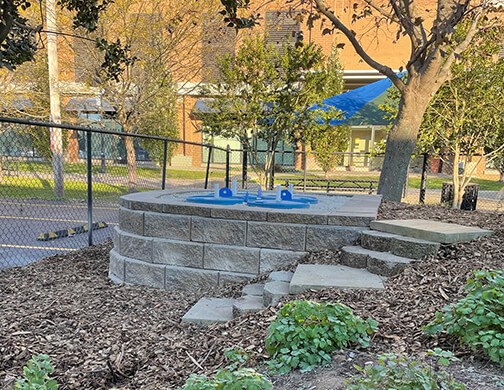
The WonderLab Vermicomposting System located in the WonderGarden. Photo by WonderLab Staff.
This spring, as the days grew warmer, the final (and some might say most exciting) ingredient was added to the new vermicomposting system in the WonderGarden: Worms! (Shout out for worms!)
This system, know as the GardenQ hybrid worm composting system, was installed in November 2021. Now that worms have been added composting can begin.
WonderLab’s goal is to have ALL food waste from the museum go into our new composting system. This waste includes museum family snacks, school group lunches, as well as scraps from Animal Ambassador and staff meals. It will also be used as an exhibit where visitors can learn about composting.
Vermicomposting lessens the impact on landfills, reduces C02 emissions, and provides a real-life educational demonstration of composting on-site.
What is vermicomposting?
Vermicomposting is the process by which worms are used to convert organic materials (usually wastes) into a humus-like material known as vermicompost. Our WonderLab employees transport food waste to the garden and place it in the vermicomposting barrels. The worms eat and digest the food scraps. Then WonderLab gardeners use their castings (worm poop) as soil. The soil produced is rich with nutrients that help our flowers grow.
When it comes to vermicomposting, not just any old earthworm will do. WonderLab uses red wigglers, a specific worm species, known to be the best vermicomposters. Unlike earthworms, red wigglers reproduce often, produce a lot of waste, and love to hang out at the top of the soil where the food is kept.
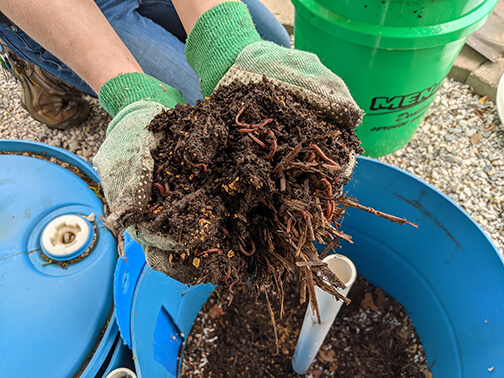
Red Wigglers. Photo by WonderLab Staff.
WonderLab’s Vermicompost System
The vermicomposting system at WonderLab is a unique layered setup that can be actively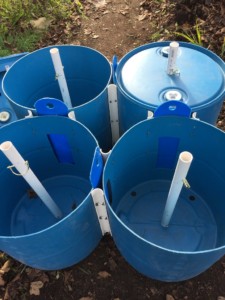
Worms wiggle their way between the barrels through slots that connect them. The slots can be opened or closed to encourage movement between the bins. Minimal amounts of carbon are released into the atmosphere.
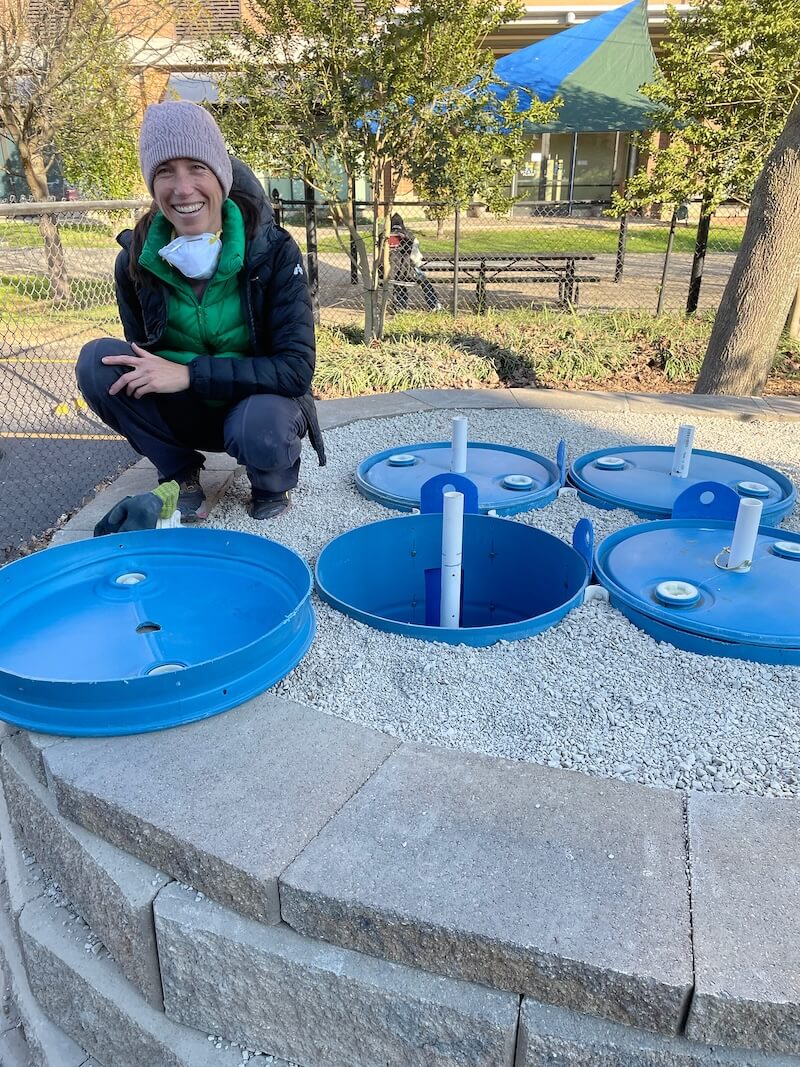
Food waste is added directly to the barrels. Photo by WonderLab Staff.
WonderLab’s vermicomposting system is designed to manage the amount of waste produced by the museum. But vermicomposting systems come in all sizes. They can be designed smaller for use in homes, apartments, offices or schools. Vermicomposting uses less space than traditional composting systems. It is an excellent solution for those who are short on space but interested in composting.
Vermicomposting at Home
There are also simple ways to build a vermicomposting system right at home. Start by finding a medium-size container with a lid. Long and wide containers work best, such as styrofoam boxes or plastic totes.
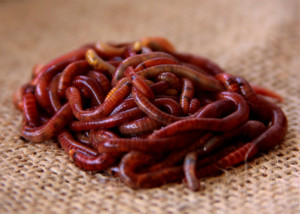
Red Wigglers. Photo by Canva. Used with permission.
The soil will need air so it is crucial to cut holes or slots into the sides of the container. Also, make keep the bottom of the container off of the ground.
Next, fill the bin with damp shredded newspaper and garden soil. Order your red wigglers online or get some from a fellow composter who has extra. Once they arrive, add them to your bin!
Store your bin and worms in a room temperature area. People often keep their bins under the kitchen sink for convenience.
What do the worms like to munch on?
Red wigglers enjoy snacking on fruits and veggies. Make sure they aren’t rotten! You can also feed your worms coffee grounds, tea bags (if the staple is removed), eggshells, and natural fibers such as yarn, cardboard, and clothing.
Do not include any oils, synthetic fabrics, acidic foods, diseased plants, onions, garlic, meat, or dairy products. These items can harm the worms and attract unwanted visitors.
When feeding the worms, add only a few pieces of food at a time. Check back often to see what your worms prefer.
Worms will eat their favorite foods within a few days. Use the the castings in your garden. Harvest your compost every three to six months, or when the bin begins to become too full.
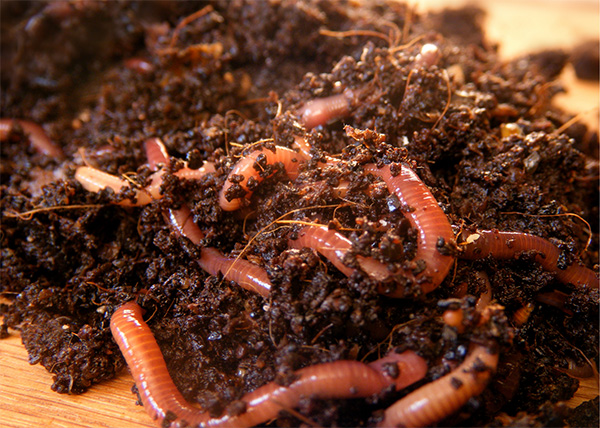
Red Wigglers in Soil. Stock photo from Canva. Used with permission.
How do you manage runaway worms?
Beware, your worms may try to run away if they are unhappy with their new living conditions! There are two things that make the worms unhappy. Overfeeding or a soggy bin.
It’s easy to make sure you are not overfeeding the worms. Begin by adding roughly one cup of food to your bin. Check back after one or two days. If the food is gone, add another cup.
Promptly remove any uneaten food so that it does not rot. Keep a record of how much the worms eat and what foods they enjoy. Your record will help you adjust the timing, amount, and type of food added to the bin.
Some vermicomposters report that they add one cup of food every two days. Others add food only once a week. It all depends on your system. So take notes!
Worms will try to escape from soggy homes. One way to dry out a soggy bin is to add more holes. More holes allow more air into the container. More air helps to dry the soil.
Worms still on the run? Place your bin in a bright place for two days. Worms are sensitive to light so they will burrow deeper into the box.
If all else fails, wrap the box with nylon stockings to cover the holes while allowing proper ventilation.
Share Your Stories with Us
Inspired to build your own vermicompost bin? Do you vermicompost? Share your story with us. We’d love to hear from you! Drop your comments and photos into the comments below.
Vermicomposting Fun Facts:
- Some state parks have designed vermicomposting toilets where modern plumbing may not be available. Learn more here!
- Worms don’t have eyes. They can tell if it is very bright or dark with the help of light receptor cells.
- Worms do not have teeth. They mechanically digest their food through a grinding motion of the muscles in the gizzard.
- Vermicomposting populations multiply rapidly! Red wiggler populations can double every two months in ideal conditions.

References
Carr, R. (2016, January 6). Vermicomposting for Beginners. Rodale Institute. Retrieved April 5, 2022, from https://rodaleinstitute.org/science/articles/vermicomposting-for-beginners/
Chrobak, U. (2019, August 14). These toilets use worms to compost your poop, and they are our future. Popular Science. Retrieved April 5, 2022, from https://www.popsci.com/composting-toilets-worms/
Dyer, M. H., & Kucharska_D-Kucharski, K. (2020, December 19). Worms Escaping Compost – How To Escape Proof A Worm Bin. Gardening Know How. Retrieved April 7, 2022, from https://www.gardeningknowhow.com/composting/vermicomposting/worms-escaping-vermicompost.htm
Grant, A., & Walker, T. L. (2021, July 27). Vermiculture Feeding – How To Feed Composting Worms Correctly. Gardening Know How. Retrieved April 26, 2022, from https://www.gardeningknowhow.com/composting/vermicomposting/care-and-feeding-of-worms.htm
How to Create and Maintain an Indoor Worm Composting Bin | US EPA. (2022, February 6). US Environmental Protection Agency. Retrieved April 5, 2022, from https://www.epa.gov/recycle/how-create-and-maintain-indoor-worm-composting-bin
Learn About Vermicomposting at Home. (n.d.). FoodPrint. Retrieved April 5, 2022, from https://foodprint.org/eating-sustainably/composting-and-food-waste/vermicomposting-101/

Leave A Comment